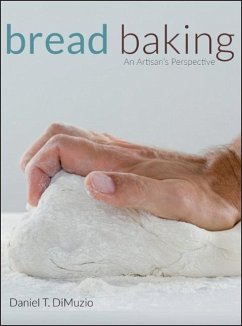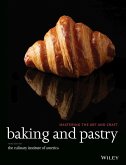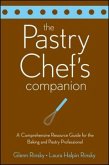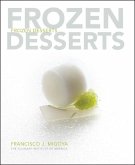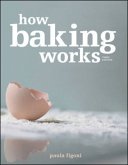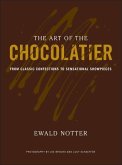- Gebundenes Buch
- Merkliste
- Auf die Merkliste
- Bewerten Bewerten
- Teilen
- Produkt teilen
- Produkterinnerung
- Produkterinnerung
A guide to making artisan breads practically and profitably, Bread Baking: An Artisan's Perspective includes step-by-step instructions on mixing, fermentation, shaping, proofing and retarding, and baking. Written for both experienced and novice bakers, Bread Baking contains more than 150 helpful photos and drawings that illustrate techniques and showcase beautiful artisan bread products. Covering the business of bread-making, this book features practical advice from successful artisan bakers as well as forty plus tested artisan bread formulas, including ciabatta, pain au levain, bagels, honey…mehr
Andere Kunden interessierten sich auch für
![Baking and Pastry Baking and Pastry]() The Culinary Institute of America (CIA)Baking and Pastry92,99 €
The Culinary Institute of America (CIA)Baking and Pastry92,99 €![The Pastry Chef's Companion The Pastry Chef's Companion]() Glenn RinskyThe Pastry Chef's Companion19,99 €
Glenn RinskyThe Pastry Chef's Companion19,99 €![Professional Cake Decorating Professional Cake Decorating]() Toba M. GarrettProfessional Cake Decorating74,99 €
Toba M. GarrettProfessional Cake Decorating74,99 €![Frozen Desserts Frozen Desserts]() Francisco J. MigoyaFrozen Desserts66,99 €
Francisco J. MigoyaFrozen Desserts66,99 €![How Baking Works How Baking Works]() Paula I. FigoniHow Baking Works57,99 €
Paula I. FigoniHow Baking Works57,99 €![The Elements of Dessert The Elements of Dessert]() Francisco J. MigoyaThe Elements of Dessert66,99 €
Francisco J. MigoyaThe Elements of Dessert66,99 €![The Art of the Chocolatier The Art of the Chocolatier]() Ewald NotterThe Art of the Chocolatier64,99 €
Ewald NotterThe Art of the Chocolatier64,99 €-
-
-
A guide to making artisan breads practically and profitably, Bread Baking: An Artisan's Perspective includes step-by-step instructions on mixing, fermentation, shaping, proofing and retarding, and baking. Written for both experienced and novice bakers, Bread Baking contains more than 150 helpful photos and drawings that illustrate techniques and showcase beautiful artisan bread products. Covering the business of bread-making, this book features practical advice from successful artisan bakers as well as forty plus tested artisan bread formulas, including ciabatta, pain au levain, bagels, honey whole wheat, croissants, and many more. Artisan bread baker and teacher Dan DiMuzio provides invaluable information on troubleshooting, ingredients, laminated dough, and creating dough formulas. Professional bakers and baking and pastry students will benefit from this practical resource to artisan breads.
Hinweis: Dieser Artikel kann nur an eine deutsche Lieferadresse ausgeliefert werden.
Hinweis: Dieser Artikel kann nur an eine deutsche Lieferadresse ausgeliefert werden.
Produktdetails
- Produktdetails
- Verlag: Wiley & Sons
- 1. Auflage
- Seitenzahl: 272
- Erscheinungstermin: 1. Februar 2009
- Englisch
- Abmessung: 283mm x 213mm x 23mm
- Gewicht: 904g
- ISBN-13: 9780470138823
- ISBN-10: 0470138823
- Artikelnr.: 25623049
- Herstellerkennzeichnung
- Produktsicherheitsverantwortliche/r
- Europaallee 1
- 36244 Bad Hersfeld
- gpsr@libri.de
- Verlag: Wiley & Sons
- 1. Auflage
- Seitenzahl: 272
- Erscheinungstermin: 1. Februar 2009
- Englisch
- Abmessung: 283mm x 213mm x 23mm
- Gewicht: 904g
- ISBN-13: 9780470138823
- ISBN-10: 0470138823
- Artikelnr.: 25623049
- Herstellerkennzeichnung
- Produktsicherheitsverantwortliche/r
- Europaallee 1
- 36244 Bad Hersfeld
- gpsr@libri.de
Daniel T. DiMuzio is formerly a baker and a bakery consultant, and is currently Chef Instructor at Culinard, The Culinary Institute of Virginia College. DiMuzio teaches a number of courses in the Baking and Pastry curriculum, including Artisan Bread, Essentials of Bread Baking, Introductory Pastry Skills, and Baking Science. He is a member of the Bread Baker's Guild of America, and has studied with such bread baking luminaries as Michel Suas, Didier Rosada, Jeffrey Hamelman, and Lionel Vatinet.
Preface ix
1 The History of Bread Making 1
A Brief History of Bread Making 2
Bread's Impact on Basic Survival 2
A Cornerstone of Civilization 2
How Bread Began 3
Bread: An Accidental Creation 3
Mechanized Bread Making 6
Direct Mixing Method 7
World War II and Its Aftermath 7
The Intensive Mix Method 8
Rescue Arrives-The Improved Mix Method 9
Renewed Interest in Great Bread 11
2 Ingredients and Their Effects 13
Ingredients for Baking Bread 14
The Most Important Ingredient: Flour 14
Wheat Dough Can Inflate 15
The Wheat Berry 15
Wheat Classification 16
Other Grains 18
Water 19
Salt 20
Yeast 21
Sweeteners 23
Fats and Oils 23
Milk Products 24
Eggs 24
Nuts, Seeds, Grains, and Dried Fruits 25
Using Whole Grains 25
Herbs and Spices 27
3 Basic Baker's Percentage (Baker's Math) 31
An International Language for Bakers 32
It's All in the Percentages 32
Changing Batch Sizes 35
Find the Total Flour Weight: Using the Percentage Sum 36
Discrepancies in Batch Size 38
When You Have Two or More Flours 38
4 Mixing Methods 41
The First 10,000 Years: Hand Mixing 42
Two Stages in the Dough Mixing Process 42
Dough Transformation During Mixing 43
Precursors to Mechanized Mixing 43
Mechanization Arrives: The Short Mix Method 44
Intensive Mix Method 44
The Improved Mix Method 47
Is There a Best Mixing Method? 47
Special Circumstances or Exceptions 50
5 Fermentation 61
Fermentation: A Process of Transformation 62
Does Fermentation Create or Destroy? 62
Fermentation of Bread Dough 63
Yeast Fermentation: Produces Carbon Dioxide and Alcohol 64
Bacterial Fermentation: Produces Organic Acids 65
Nonliving Organic Substances: Esters and Enzymes 66
Manipulating Fermentation: Time, Temperature, and Hydration 67
Pre-Ferments: How to Shorten Fermentation Time While Increasing Strength
and Flavor 68
Natural Pre-Ferments 70
6 Division and Shaping of Loaves and Rolls 77
Giving Form to Dough 78
The First Step: Division 78
Shaping Loaves and Rolls 82
7 Proofing and Retarding 105
Proofing Defined 106
Judging the Readiness of Proofed Loaves 106
Proofing versus Bulk Fermentation 107
Collapse of Overproofed Dough 107
Gas Production in Successful Proofing 107
Changing the Temperature of Dough 108
Yeast Quantity in Dough 110
The Degradation of Dough Structure 110
Retarding Loaves of Bread 111
Dough Degradation in Retarding 113
Specialized Equipment for Proofing and Retarding Loaves of Bread 113
8 Baking 121
Baking Transforms Raw Dough 122
Recognizing When Loaves Are Ready to Be Baked 122
Scoring Loaves 122
Baking Temperature 125
Using Steam 127
How to Judge the Doneness of Bread 130
The Importance of Cooling Bread after Baking 131
9 Rich and Laminated Doughs 137
The Effects Ingredients Have on Dough 138
Strategies for Turning Lean Dough into Rich Dough 139
Why Not Just Add the Fat to the Dough? 139
Lamination Defined 140
The Lamination Process 142
Differences between Croissant Dough and Danish Dough 148
Some Caveats in Working with Laminated Dough Products 149
Shaping Croissants and Danish 149
10 Creating Dough Formulas 155
Formulation: How Can We Design Our Own Reliable Bread Dough? 156
Choose Your Ingredients 157
Create a Formula, Not Just a Recipe 159
Advanced Topic #1: Flour Composition and Milling Technology 173
Elements of the Wheat Endosperm 173
The Milling Process 178
Advanced Topic #2: Advanced Baker's Percentage 181
Using Pre-Ferments in Formula Creation 181
Which Pre-Ferment Should You Use? 183
Advanced Topic #3: Controlling Fermentation: Living and Nonliving Players
185
Controlling Yeast Activity 185
Controlling Bacterial Activity 186
Enzymes: Amylase and Protease 187
Advanced Topic #4: Decorative Dough Pieces 189
Working with Decorative Dough 189
Types of Decorative Dough 189
Appendix: Formulas 193
Glossary 237
Bibliography 247
Index 249
1 The History of Bread Making 1
A Brief History of Bread Making 2
Bread's Impact on Basic Survival 2
A Cornerstone of Civilization 2
How Bread Began 3
Bread: An Accidental Creation 3
Mechanized Bread Making 6
Direct Mixing Method 7
World War II and Its Aftermath 7
The Intensive Mix Method 8
Rescue Arrives-The Improved Mix Method 9
Renewed Interest in Great Bread 11
2 Ingredients and Their Effects 13
Ingredients for Baking Bread 14
The Most Important Ingredient: Flour 14
Wheat Dough Can Inflate 15
The Wheat Berry 15
Wheat Classification 16
Other Grains 18
Water 19
Salt 20
Yeast 21
Sweeteners 23
Fats and Oils 23
Milk Products 24
Eggs 24
Nuts, Seeds, Grains, and Dried Fruits 25
Using Whole Grains 25
Herbs and Spices 27
3 Basic Baker's Percentage (Baker's Math) 31
An International Language for Bakers 32
It's All in the Percentages 32
Changing Batch Sizes 35
Find the Total Flour Weight: Using the Percentage Sum 36
Discrepancies in Batch Size 38
When You Have Two or More Flours 38
4 Mixing Methods 41
The First 10,000 Years: Hand Mixing 42
Two Stages in the Dough Mixing Process 42
Dough Transformation During Mixing 43
Precursors to Mechanized Mixing 43
Mechanization Arrives: The Short Mix Method 44
Intensive Mix Method 44
The Improved Mix Method 47
Is There a Best Mixing Method? 47
Special Circumstances or Exceptions 50
5 Fermentation 61
Fermentation: A Process of Transformation 62
Does Fermentation Create or Destroy? 62
Fermentation of Bread Dough 63
Yeast Fermentation: Produces Carbon Dioxide and Alcohol 64
Bacterial Fermentation: Produces Organic Acids 65
Nonliving Organic Substances: Esters and Enzymes 66
Manipulating Fermentation: Time, Temperature, and Hydration 67
Pre-Ferments: How to Shorten Fermentation Time While Increasing Strength
and Flavor 68
Natural Pre-Ferments 70
6 Division and Shaping of Loaves and Rolls 77
Giving Form to Dough 78
The First Step: Division 78
Shaping Loaves and Rolls 82
7 Proofing and Retarding 105
Proofing Defined 106
Judging the Readiness of Proofed Loaves 106
Proofing versus Bulk Fermentation 107
Collapse of Overproofed Dough 107
Gas Production in Successful Proofing 107
Changing the Temperature of Dough 108
Yeast Quantity in Dough 110
The Degradation of Dough Structure 110
Retarding Loaves of Bread 111
Dough Degradation in Retarding 113
Specialized Equipment for Proofing and Retarding Loaves of Bread 113
8 Baking 121
Baking Transforms Raw Dough 122
Recognizing When Loaves Are Ready to Be Baked 122
Scoring Loaves 122
Baking Temperature 125
Using Steam 127
How to Judge the Doneness of Bread 130
The Importance of Cooling Bread after Baking 131
9 Rich and Laminated Doughs 137
The Effects Ingredients Have on Dough 138
Strategies for Turning Lean Dough into Rich Dough 139
Why Not Just Add the Fat to the Dough? 139
Lamination Defined 140
The Lamination Process 142
Differences between Croissant Dough and Danish Dough 148
Some Caveats in Working with Laminated Dough Products 149
Shaping Croissants and Danish 149
10 Creating Dough Formulas 155
Formulation: How Can We Design Our Own Reliable Bread Dough? 156
Choose Your Ingredients 157
Create a Formula, Not Just a Recipe 159
Advanced Topic #1: Flour Composition and Milling Technology 173
Elements of the Wheat Endosperm 173
The Milling Process 178
Advanced Topic #2: Advanced Baker's Percentage 181
Using Pre-Ferments in Formula Creation 181
Which Pre-Ferment Should You Use? 183
Advanced Topic #3: Controlling Fermentation: Living and Nonliving Players
185
Controlling Yeast Activity 185
Controlling Bacterial Activity 186
Enzymes: Amylase and Protease 187
Advanced Topic #4: Decorative Dough Pieces 189
Working with Decorative Dough 189
Types of Decorative Dough 189
Appendix: Formulas 193
Glossary 237
Bibliography 247
Index 249
Preface ix
1 The History of Bread Making 1
A Brief History of Bread Making 2
Bread's Impact on Basic Survival 2
A Cornerstone of Civilization 2
How Bread Began 3
Bread: An Accidental Creation 3
Mechanized Bread Making 6
Direct Mixing Method 7
World War II and Its Aftermath 7
The Intensive Mix Method 8
Rescue Arrives-The Improved Mix Method 9
Renewed Interest in Great Bread 11
2 Ingredients and Their Effects 13
Ingredients for Baking Bread 14
The Most Important Ingredient: Flour 14
Wheat Dough Can Inflate 15
The Wheat Berry 15
Wheat Classification 16
Other Grains 18
Water 19
Salt 20
Yeast 21
Sweeteners 23
Fats and Oils 23
Milk Products 24
Eggs 24
Nuts, Seeds, Grains, and Dried Fruits 25
Using Whole Grains 25
Herbs and Spices 27
3 Basic Baker's Percentage (Baker's Math) 31
An International Language for Bakers 32
It's All in the Percentages 32
Changing Batch Sizes 35
Find the Total Flour Weight: Using the Percentage Sum 36
Discrepancies in Batch Size 38
When You Have Two or More Flours 38
4 Mixing Methods 41
The First 10,000 Years: Hand Mixing 42
Two Stages in the Dough Mixing Process 42
Dough Transformation During Mixing 43
Precursors to Mechanized Mixing 43
Mechanization Arrives: The Short Mix Method 44
Intensive Mix Method 44
The Improved Mix Method 47
Is There a Best Mixing Method? 47
Special Circumstances or Exceptions 50
5 Fermentation 61
Fermentation: A Process of Transformation 62
Does Fermentation Create or Destroy? 62
Fermentation of Bread Dough 63
Yeast Fermentation: Produces Carbon Dioxide and Alcohol 64
Bacterial Fermentation: Produces Organic Acids 65
Nonliving Organic Substances: Esters and Enzymes 66
Manipulating Fermentation: Time, Temperature, and Hydration 67
Pre-Ferments: How to Shorten Fermentation Time While Increasing Strength
and Flavor 68
Natural Pre-Ferments 70
6 Division and Shaping of Loaves and Rolls 77
Giving Form to Dough 78
The First Step: Division 78
Shaping Loaves and Rolls 82
7 Proofing and Retarding 105
Proofing Defined 106
Judging the Readiness of Proofed Loaves 106
Proofing versus Bulk Fermentation 107
Collapse of Overproofed Dough 107
Gas Production in Successful Proofing 107
Changing the Temperature of Dough 108
Yeast Quantity in Dough 110
The Degradation of Dough Structure 110
Retarding Loaves of Bread 111
Dough Degradation in Retarding 113
Specialized Equipment for Proofing and Retarding Loaves of Bread 113
8 Baking 121
Baking Transforms Raw Dough 122
Recognizing When Loaves Are Ready to Be Baked 122
Scoring Loaves 122
Baking Temperature 125
Using Steam 127
How to Judge the Doneness of Bread 130
The Importance of Cooling Bread after Baking 131
9 Rich and Laminated Doughs 137
The Effects Ingredients Have on Dough 138
Strategies for Turning Lean Dough into Rich Dough 139
Why Not Just Add the Fat to the Dough? 139
Lamination Defined 140
The Lamination Process 142
Differences between Croissant Dough and Danish Dough 148
Some Caveats in Working with Laminated Dough Products 149
Shaping Croissants and Danish 149
10 Creating Dough Formulas 155
Formulation: How Can We Design Our Own Reliable Bread Dough? 156
Choose Your Ingredients 157
Create a Formula, Not Just a Recipe 159
Advanced Topic #1: Flour Composition and Milling Technology 173
Elements of the Wheat Endosperm 173
The Milling Process 178
Advanced Topic #2: Advanced Baker's Percentage 181
Using Pre-Ferments in Formula Creation 181
Which Pre-Ferment Should You Use? 183
Advanced Topic #3: Controlling Fermentation: Living and Nonliving Players
185
Controlling Yeast Activity 185
Controlling Bacterial Activity 186
Enzymes: Amylase and Protease 187
Advanced Topic #4: Decorative Dough Pieces 189
Working with Decorative Dough 189
Types of Decorative Dough 189
Appendix: Formulas 193
Glossary 237
Bibliography 247
Index 249
1 The History of Bread Making 1
A Brief History of Bread Making 2
Bread's Impact on Basic Survival 2
A Cornerstone of Civilization 2
How Bread Began 3
Bread: An Accidental Creation 3
Mechanized Bread Making 6
Direct Mixing Method 7
World War II and Its Aftermath 7
The Intensive Mix Method 8
Rescue Arrives-The Improved Mix Method 9
Renewed Interest in Great Bread 11
2 Ingredients and Their Effects 13
Ingredients for Baking Bread 14
The Most Important Ingredient: Flour 14
Wheat Dough Can Inflate 15
The Wheat Berry 15
Wheat Classification 16
Other Grains 18
Water 19
Salt 20
Yeast 21
Sweeteners 23
Fats and Oils 23
Milk Products 24
Eggs 24
Nuts, Seeds, Grains, and Dried Fruits 25
Using Whole Grains 25
Herbs and Spices 27
3 Basic Baker's Percentage (Baker's Math) 31
An International Language for Bakers 32
It's All in the Percentages 32
Changing Batch Sizes 35
Find the Total Flour Weight: Using the Percentage Sum 36
Discrepancies in Batch Size 38
When You Have Two or More Flours 38
4 Mixing Methods 41
The First 10,000 Years: Hand Mixing 42
Two Stages in the Dough Mixing Process 42
Dough Transformation During Mixing 43
Precursors to Mechanized Mixing 43
Mechanization Arrives: The Short Mix Method 44
Intensive Mix Method 44
The Improved Mix Method 47
Is There a Best Mixing Method? 47
Special Circumstances or Exceptions 50
5 Fermentation 61
Fermentation: A Process of Transformation 62
Does Fermentation Create or Destroy? 62
Fermentation of Bread Dough 63
Yeast Fermentation: Produces Carbon Dioxide and Alcohol 64
Bacterial Fermentation: Produces Organic Acids 65
Nonliving Organic Substances: Esters and Enzymes 66
Manipulating Fermentation: Time, Temperature, and Hydration 67
Pre-Ferments: How to Shorten Fermentation Time While Increasing Strength
and Flavor 68
Natural Pre-Ferments 70
6 Division and Shaping of Loaves and Rolls 77
Giving Form to Dough 78
The First Step: Division 78
Shaping Loaves and Rolls 82
7 Proofing and Retarding 105
Proofing Defined 106
Judging the Readiness of Proofed Loaves 106
Proofing versus Bulk Fermentation 107
Collapse of Overproofed Dough 107
Gas Production in Successful Proofing 107
Changing the Temperature of Dough 108
Yeast Quantity in Dough 110
The Degradation of Dough Structure 110
Retarding Loaves of Bread 111
Dough Degradation in Retarding 113
Specialized Equipment for Proofing and Retarding Loaves of Bread 113
8 Baking 121
Baking Transforms Raw Dough 122
Recognizing When Loaves Are Ready to Be Baked 122
Scoring Loaves 122
Baking Temperature 125
Using Steam 127
How to Judge the Doneness of Bread 130
The Importance of Cooling Bread after Baking 131
9 Rich and Laminated Doughs 137
The Effects Ingredients Have on Dough 138
Strategies for Turning Lean Dough into Rich Dough 139
Why Not Just Add the Fat to the Dough? 139
Lamination Defined 140
The Lamination Process 142
Differences between Croissant Dough and Danish Dough 148
Some Caveats in Working with Laminated Dough Products 149
Shaping Croissants and Danish 149
10 Creating Dough Formulas 155
Formulation: How Can We Design Our Own Reliable Bread Dough? 156
Choose Your Ingredients 157
Create a Formula, Not Just a Recipe 159
Advanced Topic #1: Flour Composition and Milling Technology 173
Elements of the Wheat Endosperm 173
The Milling Process 178
Advanced Topic #2: Advanced Baker's Percentage 181
Using Pre-Ferments in Formula Creation 181
Which Pre-Ferment Should You Use? 183
Advanced Topic #3: Controlling Fermentation: Living and Nonliving Players
185
Controlling Yeast Activity 185
Controlling Bacterial Activity 186
Enzymes: Amylase and Protease 187
Advanced Topic #4: Decorative Dough Pieces 189
Working with Decorative Dough 189
Types of Decorative Dough 189
Appendix: Formulas 193
Glossary 237
Bibliography 247
Index 249

